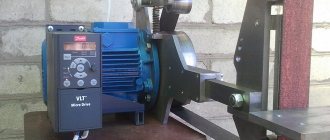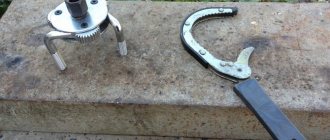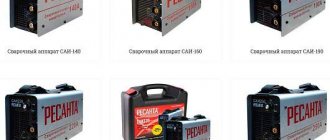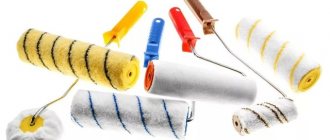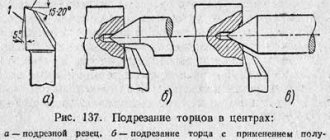Example of a hydraulic circuit for a grinding machine
Example of a hydraulic circuit for a grinding machine
Features and benefits of hydraulic drive
Hydraulic drive is a set of devices (which includes one or more volumetric hydraulic motors) designed to drive mechanisms and machines using working fluid under pressure. Hydraulic drives are one of the most rapidly developing sub-sectors of modern mechanical engineering. Compared to other known drives (including electromechanical and pneumatic), hydraulic drives have a number of advantages. Let's look at the main ones.
- Possibility of obtaining large forces and powers with limited sizes of hydraulic motors. Thus, a hydraulic cylinder with a piston diameter of 100 mm at a pressure of 70 MPa, which can be created by a hand pump, develops a force of about 55 tons, so using special jacks you can manually lift bridges.
- High performance while ensuring the required quality of transient processes. Modern hydraulic drives, for example test benches, are capable of processing a given impact with a frequency of up to several hundred hertz.
- Wide range of stepless speed control with good smoothness of movement. For example, for hydraulic motors the control range reaches 1:7000.
- Possibility of protecting the hydraulic system from overload and precise control of acting forces. The force developed by a hydraulic cylinder is determined by the area of its piston and the operating pressure, the value of which is set by adjusting the safety valve and controlled by a pressure gauge. For a hydraulic motor, the amount of torque developed is proportional to the working volume (overall dimensions of the hydraulic motor) and the effective pressure of the working fluid.
- Obtaining linear motion using a hydraulic cylinder without kinematic transformations (an electromechanical drive usually requires a gearbox, screw or rack and pinion gear, etc.). By selecting the areas of the piston and rod chambers, it is possible to ensure a certain ratio of forward and reverse stroke speeds. An important circumstance is the ideal protection of hydraulic cylinders from external contaminants, which allows the successful operation of hydraulic drives, for example, in mining equipment, excavators and other machines operating in conditions of increased environmental pollution, and in some cases under water.
- An extensive range of control mechanisms, ranging from manual control to direct control from a personal computer, makes it possible to optimally use hydraulic drives to automate production processes in various fields of technology, successfully combining the exceptional power and dynamic qualities of hydraulics with the ever-expanding capabilities of microelectronics and complex control systems.
- The extensive possibilities for energy storage and recovery provide a good basis for the development of modern energy-efficient hydraulic drive mechanisms.
- The layout of hydraulic drives mainly from standardized products, mass-produced by specialized factories, reduces manufacturing costs, improves quality and reliability, facilitates placement on a machine of a large number of compact hydraulic motors (hydraulic cylinders or hydraulic motors) powered by one or more pumps, opens up wide opportunities for repair and modernization.
Avrutin Handbook on hydraulic drives of metal-cutting machines, 1965
Biryukov B.N. Hydraulic equipment for metal-cutting machines, 1979
Leshchenko V.A. Hydraulic servo drives of machine tools with program control, 1975
Sveshnikov V.K Machine-tool hydraulic drives: reference book, 6th ed. reworked and additional 2015
Smirnov Yu.A. Malfunctions of hydraulic drives of machine tools, 1980
Kucher A.M., Kivatitsky M.M., Pokrovsky A.A., Metal-cutting machines (Album), 1972
Classification of electromagnetic hydraulic valves
Hydraulic distributors with electromagnetic control are classified according to several parameters:
- According to the nominal diameter. They can be 6 mm (DN 6) and 10 mm (DN 10). The maximum throughput of such equipment is 80 and 160 liters of working fluid per minute, respectively.
- Based on the installation method. Some are mounted on a stove, while others come in a monoblock design. The first option is installed on a specially designed block. Several sections equipped with additional valves can be attached here. Monoblock ones are produced by manufacturers in a one-piece cast body. The number of their sections can be different, ranging from 1 to 8. Monoblock hydraulic valves are most widespread in mobile equipment.
- According to the network voltage. The electromagnet can be supplied with voltages of 12, 24, 110 and 220 V. Based on this, two categories of equipment are distinguished: 12/24 V and 110/220 V.
The distributor connection diagrams may also be different. The most in demand are the following: 14 (H.00), 34 (J.04), 573E (B.32), 574 (C.11), 44 (E.01), 574E (Y.10), 574A (D. 12), 24(M.05), 64 (G.02)
All these technical parameters must be taken into account when selecting a hydraulic distributor. Only with a balanced, competent and comprehensive approach will it be possible to find a model that exactly matches the upcoming work
Hydraulic distributors types design operation marking
Hydraulic distributors are divided: according to the design of the shut-off and control element - into spool, valve and valve; number of external hydraulic lines - two-line, three-line, etc.; the number of characteristic positions of the shut-off and control element - two-position, three-position, etc.; type of control - for distributors with manual, mechanical, electrical and hydraulic control; number of shut-off and control elements - single-stage, two-stage, etc.
The symbol of the hydraulic distributor (Fig. 1) indicates the number of its positions (I, II), external hydraulic lines (A, D R, T7) connected to the distributor, their connection, as well as the control method (GOST 2.871-68*).
The number of positions is represented by the corresponding number of squares (rectangles). The passages are depicted by straight lines with arrows showing the direction of flow of the working fluid in each position, and the junctions of the passages are marked with dots; a closed passage is depicted as a dead-end line with a transverse dash. External hydraulic lines lead only to the starting position. The method of controlling the distributor is indicated by signs adjacent to the ends of the distributor designation.
To imagine the operation of the hydraulic distributor in a certain working position, it is necessary to mentally move the designation square corresponding to this position to the place of the square of the original position, leaving the communication lines in the same position. Then the true directions of the flow of the working fluid will be indicated by the arrows in this square.
The symbols are the same for spool, valve and valve hydraulic valves, i.e. the symbol does not reflect the design of their shut-off and control elements.
In addition to graphic designations of hydraulic distributors, their digital designations are also given in the form of a fraction: the numerator indicates the number of external hydraulic lines connected to the hydraulic distributor, and the denominator indicates the number of its working (characteristic) positions. For example, a four-line three-position hydraulic valve is designated by the fraction 4/3 (see Fig. 1, d).
Shut-off and control elements (spool valve, tap, valve) in hydraulic control valves always occupy fixed positions according to the “fully open” or “fully closed” principle. Therefore, the hydraulic directional valve has virtually no effect on the pressure and flow rate of the working fluid passing through it.
Introduction. Hydraulic drive composition
Semi-constructive (a) and schematic (b) representation of the hydraulic drive
In its most general form, a hydraulic drive consists of a source of hydraulic energy - a pump, a hydraulic motor and a connecting line (pipeline).
On the hydraulic diagram Fig. 1.4 semi-structurally (a) and schematically (b) shows the simplest hydraulic drive, in which pump 2, driven by electric motor 11, sucks up working fluid from tank 1 and through filter 4 supplies it to the hydraulic system, and the maximum pressure is limited by the adjustable force of the spring of safety valve 3 (controlled pressure gauge 10). To avoid accelerated wear or failure, the relief valve setting pressure should not be higher than the pump's rated pressure.
Depending on the position of the distributor handle 5, the working fluid through pipelines (hydraulic lines) 6 enters one of the chambers (piston or rod) of the cylinder 7, forcing its piston to move along with the rod and working body 8 at a speed v, and the liquid from the opposite chamber through the distributor 5 and adjustable resistance (throttle) 9 is forced into the tank.
When the throttle is fully open and there is a slight load on the working body, all the working fluid supplied by the pump enters the cylinder, the movement speed is maximum, and the value of the working pressure depends on the losses in the filter 4, devices 5 and 9, cylinder 7 and hydraulic lines 6. Closing the throttle 9, You can reduce the speed until the working body stops completely. In this case (as well as when the piston stops against the cylinder cover or the load on the working element increases excessively), the pressure in the hydraulic system increases, the safety valve ball 3, compressing the spring, moves away from the seat and the working fluid supplied by the pump (pump supply) is partially or completely bypassed through safety valve into the tank at maximum operating pressure.
During prolonged operation in bypass mode, due to large power losses, the working fluid in the tank quickly heats up.
The following symbols are presented on the hydraulic diagram:
- source of hydraulic energy - - pump 2;
- hydraulic motor - cylinder 7;
- guide hydraulic equipment - distributor 5;
- regulating hydraulic equipment - valve 3 and throttle 9;
- control devices - pressure gauge 10;
- reservoir for working fluid - tank 1;
- working environment conditioner - filter 4;
- pipelines — 6.
Hydraulic drives of stationary machines are classified according to pressure, method of regulation, type of circulation, control and monitoring methods.
Hydraulic distributor with gearbox
The hydraulic distributor with a gearbox consists of the following main components: a hydraulic distributor with a worm gearbox and safety hydraulic valve boxes 17 and shut-off hydraulic valves attached to the hydraulic distributor body. The hydraulic distributor is used to control power hydraulic cylinders and consists of a spool housing 16, a spool 9 and a centering device consisting of springs 10 and plungers 12, on which washers 8 rest.
The centering device ensures that the spools are held and returned to the neutral position. In the spool housing 16 there are five annular grooves that serve to supply and drain oil. To reduce oil leaks in the hydraulic distributor, the diametrical clearances between the spool and the body must be minimal, which is achieved by selecting a spool-housing pair.
The hydraulic distributor is fastened with studs 11 and nuts 13 to the housing 5 of the worm gearbox. The worm gearbox consists of a housing 5, a worm 4 and a sector 3.
The worm 4 rotates on two needle bearings 2. The upper short end of the worm has splines that engage with the splined clutch of the steering column drive shaft.
At the lower left end of the worm, a spool 9, support washers 8 and thrust bearings 7 are installed. The degree of tightening of the thrust bearings is adjusted by nut 14 when assembling the unit. Sector 3 is made integral with the roller and rotates on two tapered roller bearings 22. The worm pair and sector bearings are installed using spacers 21.
The output end of the sector shaft is sealed with two rubber rings 19. A bipod 18 is secured to the shaft using conical splines and a nut. There are marks on the crankcase cover 20, the end of the sector shaft 3 and the bipod 18. When these marks are combined, the sector and bipod occupy a position corresponding to the linear movement of the tractor.
A safety hydraulic valve box is attached to the lower part of the hydraulic distributor housing, consisting of a housing 4, which houses a hydraulic valve seat 5, a ball 7, a guide 8 and a spring 3. The hydraulic valve is adjusted using a screw 2 to a bypass pressure of the entire flow of 10.5 + 0.5 MPa (105+5 kgf/cm2). The adjusting screw is fixed with nut 9 and cap 1. A box of shut-off hydraulic valves is attached to the upper part of the hydraulic distributor housing, which houses shut-off hydraulic valves 3 with a spring 2 and a pusher 4. The shut-off hydraulic valves serve to lock the cavities of the power hydraulic cylinders when external forces act on the rods.
Sealing of the joints of parts and assemblies is made using rubber O-rings.
Disassembly and assembly of the unit and all adjustments should be carried out only if necessary in a special workshop by trained persons.
Common hydraulic valve malfunctions and repairs
Most often you may encounter the following problems with the MTZ hydraulic distributor installed on the Belarus tractor:
- Violation as a result of wear of the tightness between the spool and the hydraulic distributor housing;
- Worn hydraulic cylinder piston;
- Destruction of the gear pump;
- The appearance of cracks in rubber seals;
- Violation of the tightness of the connecting fittings;
- Damage to hydraulic system pipelines.
The simple design of the device allows it to be repaired without the participation of service specialists. Often machine operators do it with their own hands. In addition, a special repair kit recommended by the company that produces these products can significantly simplify the repair of the MTZ 82 hydraulic distributor.
The P80 hydraulic distributor, developed many years ago, due to its successful design and high reliability, is successfully used on modern Belarus 920 and MTZ 3022 tractors.
Video from YouTube
Design and principle of operation
Hydraulic distributors can be used when working with various types of liquids. But most often such a mechanism can be found in hydraulic systems to regulate the flow, level and pressure of oil.
The operating principle of the electrical distributor is as follows:
- A DC electromagnet is installed on the body, which, when turned on, acts on the pin and the pusher, to which it is attached using a lever.
- The pusher acts on the ball valve, pressing it against the seat;
- This position allows the hydraulic motor to start working, displacing liquid from the working container into the drain line.
- When no electricity is supplied to the solenoid, the ball valve is pressed against the seat.
- Because of this, the working container is connected to the discharge cavity, which leads to the reverse movement of the liquid, which returns to the engine cavity.
- The working container is closed with a check valve, which does not allow liquid to move in the system.
- The distributor does not require much power to operate, since the entire system is balanced. The force of the spring that acts on the ball valve is approximately equal to the pressure from the pusher, into the cavity of which the working fluid is pumped. Because of this, even the slightest force of the electromagnet is enough to change the direction and distribution of fluid flows.
Almost all distributor models work on the same principle. The differences may be minor and depend on the design features.
Line (stream) symbols
Working, pilot and drain lines
A hydraulic hose, pipe, or other conduit that moves oil between components of a hydraulic system is indicated by a single line.
The working line (suction, discharge and return) is indicated by a solid line.
The pilot line is indicated by a dotted line with long dashes
The drainage line is indicated by a dotted line with short dashes
Connection/Transition Lines
To show that two intersecting lines are not connected, we use a short loop on one of the lines at the intersection.
The connection between two intersecting lines should be indicated by a dot at the junction.
Application area
The scope of application of hydraulic distributors is not limited to certain areas of activity. Almost every hydraulic system uses such a mechanism. The most common are spool models. This is because they are easy to use, relatively cheap and small in size. These valves are usually used to control the movement of engine components.
You can usually find such hydraulic distributors on:
- machines:
- crane installations, lifts and manipulators;
- trucks;
- agricultural machinery;
- special equipment used in construction and mining.
The scope of application of such models is limited only by the level of pressure of the working fluid. If the permitted values are exceeded, the system may not be able to withstand and fail due to loss of fluid. For heavy loads, preference should be given to valve devices.
Crane models are rarely used due to their low throughput. They are often found in combination with spool and valve devices as an additional mechanism.
When purchasing a distributor, you should study the technical characteristics of each model. Sometimes it is best to consult a specialist. The reliability of the hydraulic system directly depends on the distributor. It is worth noting that even if you choose the right device, problems may arise if it is installed incorrectly
Therefore, such an important stage should also be treated with special attention.
Main advantages of electromagnetic hydraulic valves
This equipment stands out from its analogues due to the following advantages:
- the ability to stop the fluid and restart it at any point in the hydraulic system;
- the ability to quickly and easily replace an electromagnet without depressurizing the system and leaking the working medium;
- efficiency in energy consumption;
- compact dimensions and light weight, which greatly simplifies installation work;
- when replacing the working medium there is no need to change the seals;
- ensuring enviable operating parameters;
- high efficiency of the system even in intensive operation.
A fairly significant advantage is maintainability. During operation of the unit, wear of bushings, seals, and valve failures will occur, caused by contamination of the working fluid with wear products. All this can be easily replaced with a new one, restoring the functionality of the unit. More serious breakdowns are also possible, but for the most part they can be eliminated quickly and without much material expense.
<< Popular Hydraulic distributors Badestnost
Prevention
To ensure efficient operation of the tractor hydraulic system, it is necessary to follow the rules of operation and timely maintenance.
When working with equipment equipped with hydraulics, its components should be regularly checked for malfunctions. The occurrence of a small-scale failure inevitably leads to failure of other parts of the system. If one is detected, you must immediately use all available means to eliminate it:
do not allow the required load on the hydraulic pump, hydraulic cylinders, oil hoses and other components to be exceeded; avoid excessively high pressure, if necessary, release it in a timely manner or select a suitable control valve; To maintain stable operation of the hydraulic mechanism, it is important to change/add fluid to the system in a timely manner: insufficient quantity will lead to a decrease in operating efficiency and rapid failure of the unit; All maintenance and repair work on the system should be carried out with the tractor engine turned off (cold) after releasing the pressure.
Table of common hydraulic system faults and how to fix them:
| Malfunctions and their causes | Remedy |
| Malfunction: low lifting and pushing force of hydraulic cylinders or its complete absence. Reason: the oil level in the system has dropped. | Add oil. |
| An oil with unsuitable characteristics was used. | Replace the oil with a suitable one. |
| The oil or hydraulic cylinder filter is dirty. | Replace or wash the filter element. |
| Presence of air in the system. | Blow out the system - remove air, identify the point of its penetration and eliminate it. |
| Presence of fluid leakage through worn seals. | Replace the seals with new ones. |
| The operation of the pressure relief valve is disrupted - it gets stuck in the open position. | Wash/blow out the valve. Replace if necessary. |
| Malfunction in the valves of the hydraulic distributor. | Replace valves or their parts, if necessary, replace the entire unit. |
| Leaks in the system's connecting points. | Check for leaks, fix those found by crimping, tightening, installing clamps, replacing. |
| Malfunction of the piston or hydraulic cylinder seals. | Check the hydraulic cylinder for pressure leaks. Replace seals and piston. If necessary, change the entire assembly. |
To learn how to install hydraulics on a mini-tractor with your own hands, see the following video.
Design and principle of operation
Hydraulic distributors can be used when working with various types of liquids. But most often such a mechanism can be found in hydraulic systems to regulate the flow, level and pressure of oil.
The operating principle of the electrical distributor is as follows:
- A DC electromagnet is installed on the body, which, when turned on, acts on the pin and the pusher, to which it is attached using a lever.
- The pusher acts on the ball valve, pressing it against the seat;
- This position allows the hydraulic motor to start working, displacing liquid from the working container into the drain line.
- When no electricity is supplied to the solenoid, the ball valve is pressed against the seat.
- Because of this, the working container is connected to the discharge cavity, which leads to the reverse movement of the liquid, which returns to the engine cavity.
- The working container is closed with a check valve, which does not allow liquid to move in the system.
- The distributor does not require much power to operate, since the entire system is balanced. The force of the spring that acts on the ball valve is approximately equal to the pressure from the pusher, into the cavity of which the working fluid is pumped. Because of this, even the slightest force of the electromagnet is enough to change the direction and distribution of fluid flows.
Almost all distributor models work on the same principle. The differences may be minor and depend on the design features.
Varieties
Depending on the type of main element, you can buy the following hydraulic valves:
- spool type;
- valve type;
- crane type.
Spool valves
The main element of such distributors is a cylindrical or flat spool. In the simplest scheme, everything happens as we described above. In the “quiet” position, the spool closes the channels. When it moves to the left, the liquid rises into the left cavity of the cylinder, as a result of which the piston moves to the right. If the mechanism is moved to the right, the liquid will begin to fill this side of the hydraulic cylinder, forcing the rod to retract back. The process of returning the piston to its original position is usually faster, since the filling area is smaller.
Based on the number of fluid flow lines, two-, three-, and multi-port hydraulic valves are distinguished. The system control can be manual or hydraulic, electromagnetic or electrohydraulic. When using only muscle power, a button, lever, rotary handle or foot pedal is used. In the case of a mechanical device, the process is started by a pusher, roller or spring. Pressure can be direct hydraulic or pneumatic.
Often the system uses several spools at once. Such designs are divided into monoblock and sectional. If there are several compartments, they are connected with bolts. The shut-off and control mechanism for this type of distributor is available in three versions: with positive, zero and negative axial overlap. Each of them has its own advantages and disadvantages.
The advantage of the first option is the ability to fix the position of the piston. Minus: there is a dead zone within which the actuator does not move even in the presence of a signal. Spools with zero axial coverage do not have such an area. Their disadvantage is the relatively high cost associated with difficulties in manufacturing. Models with negative overlap have a minimal dead zone. The negative factor here is the less rigidity of the structure.
Crane
These hydraulic valves regulate flows by turning the valve plug. The most popular products are cylindrical and conical in shape. Flat and spherical models are also available. One of the most important characteristics of such devices is tightness. Over time, the gap between the plug and the valve body may increase, resulting in leakage of the working fluid.
Users of hydraulic valves with a cylindrical plug most often encounter this problem. Initially, the gap between the surfaces is 0.01...0.02 mm. As the structure wears out, the plug and the body begin to fit together less tightly. You have to either put up with constant fluid losses (after all, they are not too great), or buy a new device. Models with a conical plug do not have this problem, which makes their purchase more profitable.
Valve
Hydraulic distributors, which use a valve as a shut-off and control element, are capable of operating at high pressure. If spool designs are limited to a nominal value of 32 MPa, then valve designs can withstand loads two to three times greater. The flow vector of the working fluid is regulated by sequential opening/closing of the passage channels.
When the motor needs to be activated, the operator moves the rod on which the protrusions are located. As a result of this movement, one of the pairs of valves opens, and the liquid begins to move through the corresponding channel. It either enters the hydraulic motor or is drained into the tank. At the end of the process, the rod returns to its original position.
Valves for distributors can have a variety of shapes, ranging from balls to cones. They are controlled manually, mechanically or electrically. Of the devices driven by muscular efforts, the most widespread are elements with a swinging lever. In many designs, the valves are opened/closed using a cam drive.
The ability of these hydraulic valves to withstand severe pressure affects the dimensions and weight of the products. They are significantly heavier and larger compared to spool-type models that pass the same amount of working fluid. You should also take into account the sharp fit of the valves on the seat. From time to time, serious water hammer may occur, which negatively affects the operation of the entire system and its service life. In view of this, such devices are not recommended for use in structures where high inertia of moving masses is allowed.
Application area
The scope of application of hydraulic distributors is not limited to certain areas of activity. Almost every hydraulic system uses such a mechanism. The most common are spool models. This is because they are easy to use, relatively cheap and small in size. These valves are usually used to control the movement of engine components.
You can usually find such hydraulic distributors on:
- machines:
- crane installations, lifts and manipulators;
- trucks;
- agricultural machinery;
- special equipment used in construction and mining.
The scope of application of such models is limited only by the level of pressure of the working fluid. If the permitted values are exceeded, the system may not be able to withstand and fail due to loss of fluid. For heavy loads, preference should be given to valve devices.
Crane models are rarely used due to their low throughput. They are often found in combination with spool and valve devices as an additional mechanism.
When purchasing a distributor, you should study the technical characteristics of each model. Sometimes it is best to consult a specialist. The reliability of the hydraulic system directly depends on the distributor. It is worth noting that even if you choose the right device, problems may arise if it is installed incorrectly
Therefore, such an important stage should also be treated with special attention.
Miscellaneous
Tank
A rectangle with a long side horizontally is a symbol of a tank. The open top symbol indicates a vented tank. The closed top symbol indicates a sealed tank.
Battery
The accumulator is oval in shape and may have additional parts to indicate spring pressure or gas charge.
Oil cooler
The oil cooler is shown as a square, rotated 45° and has connections at the corners.
Filter/Strainer
Dotted line inside a rotated square
Loader and excavator equipment
MTZ tractors can be equipped with various types of loaders.
There are loaders with hydraulic power from the tractor hydraulic system. They are connected by high-pressure oil lines to the corresponding outlets of the hydraulic distributor through breakaway couplings. Loader versions with their own hydraulic valves are also available. Such models are connected directly to the oil pump, while the hydraulic outputs of the tractor distributor remain free and can be used with other mechanisms.
If it is necessary to equip a tractor with an excavator, the following must be taken into account:
- Most likely, you will have to replace the standard tractor distributor with a more powerful one if the equipment is not equipped with an autonomous hydraulic system. This will protect the hydraulic system from sudden pressure surges and oil overheating.
- If the excavator is equipped with its own hydraulic system, then it is connected directly to the power take-off shaft.
- A special hitch is installed on the tractor, which allows you to shift the center of gravity of the machine towards the boom, which gives greater stability.
- Hydraulic supports are mounted, which also ensure the stability of the tractor during excavation work.
The need for a hydraulic distributor on a tractor
The three-section distributor R-80 3/1 222G is used in the hydraulic system of the Belarus 80 tractor for the following functions:
- protects the system from hydraulic overloads during lifting or forced lowering;
- distributes the flow of hydraulic fluid, which is pumped by a hydraulic pump between system units (hydraulic cylinders, hydraulic motors);
- unloads the system at idle with neutral output due to the transfer of transmission oil into the oil tank;
- connects the working volume of the hydraulic cylinder to drain the process fluid (when operating in a neutral position).
In addition, the hydraulic distributor P80 3/1 222G serves as a basic device on which modifications are made for use on loading units, excavators and road construction equipment. The technical characteristics and parameters of the distributor can be found in the description of the P80 marking, where:
- R – distributor.
- 80 – nominal transmission fluid consumption (l/min).
- 3 – version according to process pressure (permissible 20 MPa, nominal 16 MPa).
- 1 – type of operational purpose (autonomous use in hydraulic systems).
- 222 – three special spools made according to option two.
- G – hydraulic locks (check valves).
Change of oil
The oil in the hydraulic system is usually changed seasonally during maintenance or every 2000 operating hours. However, if low-quality oils are used, or if they are contaminated, an unscheduled replacement may be necessary.
This procedure consists of several important steps:
- Turn on the gear pump.
- Start the engine.
- Warm up the oil in the hydraulic system to 20-30 degrees.
- They turn off the engine.
- The oil is drained through the drain hole of the hydraulic tank after unscrewing the filler neck.
- Remove the filter and housing and wash it in diesel fuel.
- Reinstall the filter.
- Close the drain plug.
- Oil is poured through the filler neck to level “P” in the control window.
- Start the engine and bleed the hydraulic system by raising and lowering the hitch.
- If necessary, add oil to the tank.
Operating principle
Hydraulic distributors are made of high quality steel, modified cast iron or bronze. Some elements are treated for additional protection: they are nitrided, cemented, etc. Size and weight depend on the volume of working fluid. The more it passes through the system, the more impressive the dimensions and weight are usually.
Let's consider an elementary diagram of the operation of a hydraulic distributor. In the initial state, liquid from the pump does not flow into the hydraulic cylinder. As soon as the operator moves the shut-off and control mechanism in one direction, it begins to flow into the corresponding cavity of the cylinder, causing the piston to start moving. The liquid that the piston begins to displace goes down into the tank. After completing the task, the operator returns the mechanism to its initial position.
The devices can be guiding or throttling. In the first case, the distributor only opens or closes the fluid passages. Throttling models provide the ability to regulate the flow rate. This occurs due to the ability of the locking and regulating mechanism to open the channel not only entirely, but also partially. The advantage of such designs is the absence of sharp shocks when turning the mechanism on/off.
Help in selecting equipment
Your message has been successfully sent!
How residents can install a distributor: procedure
An owner who wants to reduce heating bills must begin by obtaining permission to install the device.
To do this, the owner should:
- Find out whether a thermal energy control unit is installed in an apartment building;
- Find out from the management company whether 50% or more of the apartments in your building are equipped with distributors;
- Coordinate the installation of distributors with the organization supplying energy resources. Obtain permission from the Management Company;
- Replace heating radiators with modern models. The use of old batteries and homemade registers is prohibited. Install thermostatic regulators that allow temperature adjustment to create a comfortable room microclimate;
- Installation of heat distributors is carried out by a certified specialist or developer, taking into account the heat distribution throughout the house;
- Concluding an agreement that details the procedure for taking readings, recalculation and the responsibilities of the parties.
Possible consequences of contamination
There are two main consequences of the presence of contaminants in hydraulic fluid:
- Decreased hydraulic efficiency. This leads to a sharp decrease in the efficiency of all equipment/machinery. Typically, effectiveness decreases gradually and is difficult to detect if the inspector does not have the necessary knowledge and experience. At a minimum, such an effect will lead to a sharp increase in fuel consumption.
- The presence of contaminants accelerates the wear of parts that make up the hydraulic system. Statistics show that 75-85 percent of malfunctions of the most important hydraulic elements are associated precisely with the presence of contaminants in the fluid used. There are three main types of wear: abrasive, adhesive, and fatigue.
Abrasive type wear
The presence of abrasive particles in the hydraulic fluid leads to scraping of metal from the elements of this system.
This not only accelerates the wear of critical hydraulic components, but also increases the overall level of contamination, which accelerates the occurrence of various troubles. Fatigue-type wear
High pressure and shock loads constantly applied to parts of the hydraulic system cause metal chips to form, which further contaminate the hydraulic fluid.
Adhesive type wear or obliteration
Various particles found in the hydraulic fluid begin to adhere to the metal surfaces of the system. The result is that the valves stop functioning correctly, and the liquid itself cannot circulate effectively in the system.
Design solution for electromagnetic hydraulic valves
Hydraulic valves with an electromagnetic drive are structurally composed of a durable cast-iron body in which a spool is placed. Moving along the internal channel, it communicates with each other different channels for supplying and discharging the working fluid, redirecting it in the required quantity to one or another executive body. Return springs act on the spool through washers. All working channels are located in the lower mounting plane and are sealed with round rubber rings. Stable pressure of the working fluid is ensured by the wide passage of the valve.
The electromagnets, through which the distributor is controlled, are mounted directly on the housing. If both magnets are turned off, the spool moves to the neutral position. On-off valves have only one magnet installed. Instead of the second one, a blind cover is provided. Some models additionally provide a button for manual control of the electromagnets. With its help, the operator will check how correctly the spool moves and will be able to switch the distributor manually if the electromagnet does not work (possibly due to problems with the power supply).
The electromagnet itself can be either AC or DC. Structurally, it consists of a coil and a reinforcing tube in which the plunger is placed. The cavity is filled with oil, so that even with intensive use this element does not wear out.
How much does a distributor for T 25 cost?
6,900 rub. 6300 RUR/pcs.
Interesting materials:
How to properly reheat McDonald's fries? How to dilute henna correctly? How to properly dilute starch for starching? How to properly dilute starch into jelly? How to properly dilute nicotinic acid? How to properly dilute and use egg powder? How to properly propagate fresh yeast? How to properly cut a turkey? How to properly cut potatoes for rustic potatoes? How to properly cut potatoes for stewing?
Spool valves
Valve distributors provide better tightness; they are able to operate at higher pressures than spool valves.
Distributors with a spool valve are more compact; they allow smooth closing of the working windows, which is important in the presence of large inertial masses. Let's take a closer look at the design, characteristics and operating principle of spool valves, which have become widespread
Let's take a closer look at the design, characteristics and operating principle of spool valves, which are widely used.
Number of hydraulic valve positions
The number of options for connecting hydraulic lines with a distributor is called the position number. The most widespread are two- and three-position valves.
Neutral is the position in which the spool is installed in an inactive state under the influence of simultaneously acting forces (for example, spring force).



